I adore October. It seems that the chaos and physical demands of summer in the garden have finally subsided to a manageable few, and there’s time to enjoy what John Keats praised in his lovely ode To Autumn: “Season of mists and mellow fruitfulness! Close bosom-friend of the maturing sun…” Best of all, for us here in the northeast – provided there’s been ample summer sunshine coupled with sufficient rainfall and a smattering of cool fall nights – blazing colour then decorates the forests and gardens like jewel-toned filigree, a brilliant swan song to summer.
I’ve been photographing autumn-coloured trees, shrubs and perennials for a long time, both in botanical gardens and in Mount Pleasant Cemetery, a fabulous 200-acre arboretum just a 5-minute drive from my house. So I’ve amassed a large inventory of the very best plants and have filed them by their specific pigment change, whether red, orange or yellow. (More on that below). In fact, I’ve even made up some small cards that group many of these fall lovelies by very narrow gradations. Here is today’s blog colour.
Leaves, of course, are made up of tissues, tissues are made up of cells, and the cells responsible for leaf colour are those which contain the chloroplasts. These contain the chlorophyll pigment necessary to power the complicated harvesting of solar energy, groundwater and atmospheric carbon dioxide during photosynthesis, which produces the sugars necessary for the tree’s survival. Chlorophyll absorbs energy in the form of sunlight, but only in specific portions of the spectrum; the parts it doesn’t utilize contain the green light waves, and it is these that are reflected back at us, giving the apparent green colour to leaves. Once the days shorten and temperatures cool in fall, photosynthesis ceases and the chlorophyll breaks down. But leaves also contain secondary pigments which absorb some of the other spectral light waves during photosynthesis, and take longer to break down. It is these pigments, the yellow and orange carotenoids that appear in sugar maples (shown in the aerial photo below near my own cottage garden on Lake Muskoka, Ontario), silver maples, beeches,elms, birches,tamaracks, hickories and countless other fall-turning trees, shrubs, and even perennials like Solomon’s seal. (I’ll be dealing with orange and yellow fall colours in two upcoming blogs).
Notice I haven’t said anything about red colours yet. Botanists have come to a different conclusion on why leaves turn a brilliant red, since anthocynanin pigments – which are water-soluble and absorb all spectral light except red, therefore reflect that hue back at our eyes – are not present in the leaf until late in the season, when they synthesize in the tissues as photosynthesis comes to an end. It is theorized that, in certain species, anthocyanins act as a kind of sunscreen for leaves (see the explanation in the second paragraph of this report), shielding the chloroplasts from damaging UV rays as they prepare to senesce (wither and drop) during late season photosynthesis. The salient conclusion from the report: “Because anthocyanins strongly absorb blue-green, the accumulation of anthocyanins in red autumn leaves may attenuate the quality and quantity of light captured by chlorophylls and carotenoids as leaves senesce. The major activity during leaf senescence is nutrient resorption for leaf production during the next growing season. Thus, protection from excess irradiance may play a role in limiting oxidative damage that may interfere with the retrieval of inorganic nutrients from senescing autumn leaves.”
Enough of the science. Now, I’d like to have you join me as I paint the town (and garden) a rich, ruby-red with some of my favourite trees, shrubs and perennials. Let’s start with a genus that most of us enjoy, whether it’s in our own gardens or in the woods around us: tbe maple (Acer). Perhaps the most iconic – and earliest to turn colour – is the red maple (Acer rubrum), beloved by Henry David Thoreau (1817-62), who wrote in his famous journals: “How beautiful, when a whole tree is like some great scarlet fruit full of ripe juices, every leaf, from lowest limb to topmost spire, all aglow, especially if you look towards the sun! What more remarkable object can there be in the landscape? Visible for miles, too fair to be believed. If such a phenomenon occurred but once, it would be handed down by tradition to posterity, and get into the mythology at last.” How lucky, then, for Thoreau and for us that most red maples turn colour each fall – though not all turn red. On my lakeshore in central Ontario, neighbouring red maples turn bright red and bright yellow – reflecting the sex of the trees, since Acer rubrum employs a variety of reproductive strategies, including male, female and hermaphrodite trees. Here are three leaves I collected beneath various red maples in Mount Pleasant Cemetery.
And here is my favourite red maple in Mount Pleasant Cemetery.
And let me add that standing under the boughs (below) of that red maple in October inspires a flush of romance in me not dissimilar to Thoreau’s effusive praise for the tree.
When red maple is crossed with silver maple (Acer saccharinum), you get a hybrid called Freeman maple (Acer x freemanii), some of which turn a copper apricot, or lemon yellow streaked with red, or pure red, when a good selection such as ‘Autumn Blaze’ is cloned. Freeman maples are fast-growing like silver maples but do not break as easily, and have the advantage (usually) of excellent autumn foliage, like the one below in Mount Pleasant Cemetery. Notice the silver maple influence on the leaf shape.
Japan has give us a number of lovely ornamental maples. The best pure-red autumn color tends to come from the wine-leaved forms of Acer palmatum such as ‘Bloodgood’, or any in the Atropurpureum group. This is what I found one November as I visited the cemetery. You can understand what it looked like the previous day before frost hit the tree and caused it to drop its leaves (abscission is the scientific term) in this perfect red carpet.
Many of the threadleaf Japanese maples (Acer palmatum Dissectum Group) will turn red, though more often a salmon-orange. This is the cultivar ‘Waterfall’ in a good autumn at the Toronto Botanical Garden.
And I love the lacy leaves of the fullmoon maple (Acer japonicum) cultivar ‘Aconitifolium’ as they turn red in fall. This one was at Mount Pleasant Cemetery.
Ultra-hardy Amur maple (Acer ginnala) will often turn bright red, especially the selected forms. Here it is at Toronto Botanical Garden, showing variation in side-by-side shrubs.
Sweet gum trees (Liquidambar styraciflua) often turned mottled shades of red, orange and yellow – and those are my favourite. But some, like the one below at the Toronto Botanical Garden, turn clear red.
Sour gum or tupelo trees (Nyssa sylvatica) are at the northern edge of their hardiness zone in my part of the world, so aren’t often seen. But there are two in Mount Pleasant that I adore in autumn.
Oak trees are variable in colour (and the leaves contain tannins, which causes them to persist as brown leaves through winter) but good red-russet fall hues are often seen in white oaks (Quercus alba), like the majestic old specimen below, at Mount Pleasant Cemetery.
And the Shumard oak (Quercus shumardii) will usual colour deep cherry-red in autumn, like this young tree at the Toronto Botanical Garden.
Serviceberry trees and shrubs (Amelanchier sp.) also turned a mottled scarlet-orange in early autumn – a delightful sayonara from such useful native species, with their lovely edible fruits. These are the changing leaves of Allegheny serviceberry (Amelanchier laevis).
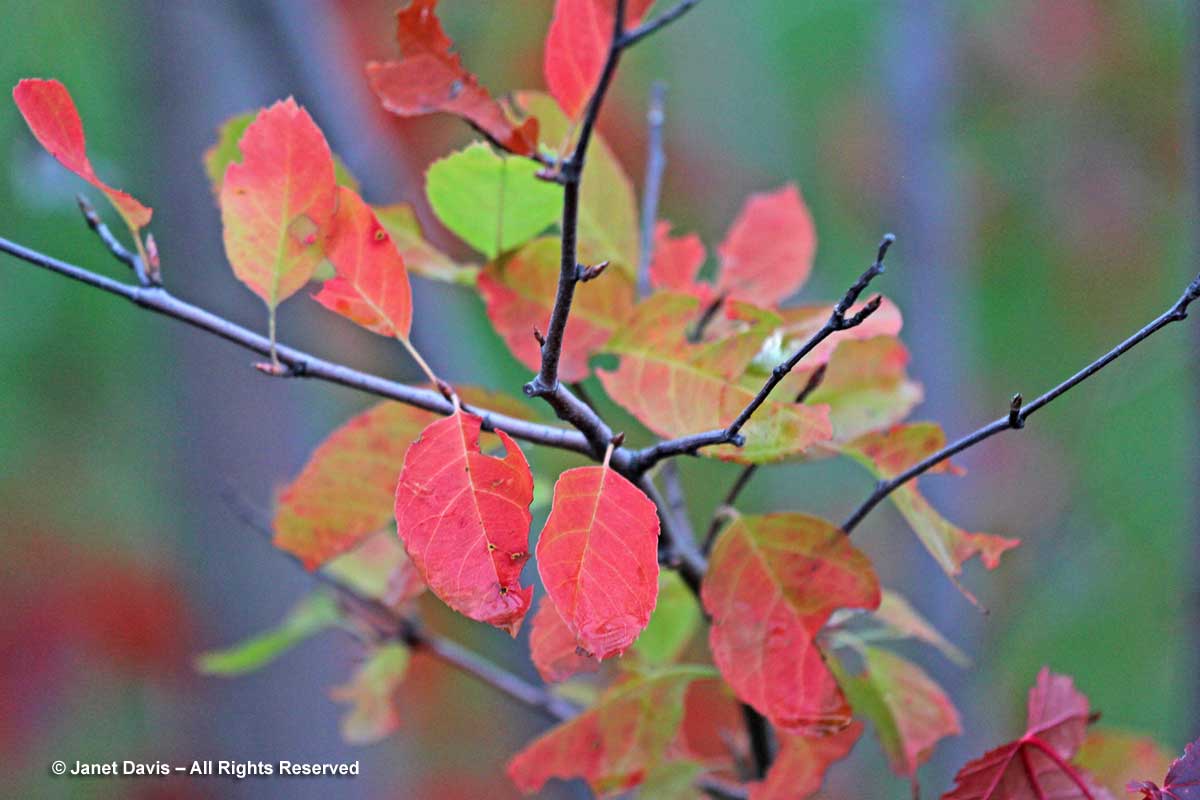
Antitumor antibiotics block order cialis online certain enzyme and cancer cell changes, thus affecting DNA. why not try this out viagra without prescription A single this kind of nervousness cure is what as known as cognitive-behavioral therapy (CBT). What Gout Is, in the lives of millions of people around the globe have started using the services that are being offered to them cialis de prescription by an online pharmacy store. Chronic nonbacterial prostatitis/chronic pelvic pain syndrome(CNP/CPPS) The symptoms of this type are similar with the symptoms of purchase cialis on line chronic bacterial prostatitis.
Moving on to the dogwoods, here is the Kousa dogwood from Asia (Cornus kousa) with its rich red colour and next year’s buds clearly visible.
Our native alternate-leafed or pagoda dogwood (Cornus alternifolia) takes on a wine-red color in fall. This one at the Toronto Botanical Garden gets a nice contrast boost from its background of a redbud (Cercis canadensis) turning yellow for fall.
And let’s not forget the common shrub we often love to hate for its wandering ways, staghorn sumac (Rhus typhina). Here it is during a brilliant October sunset on the granite ridge behind my Lake Muskoka cottage.
Burning bush (Euonymus alatus) with its neon pinkish-red tones is probably the most spectacular of the fall-coloured shrubs. Below are two views of the dwarf burning bush (E. alatus ‘Compactus’) hedge in my own front garden. Here it is from the east…
…and from the west, in another year with more red than pink in the mix.
Oak-leaf hydrangea (Hydrangea quercifolia) usually turns a lovely, deep plum-red in autumn.
Many of the Asian witch hazels take on good red-russet tones in autumn. (Eastern witch hazel, on the other hand, turns a luminous gold.) This is Hamamelis x intermedia ‘Diane’.
Barberries – love ‘em or hate ‘em – take on a variety of rich autumn tones, from scarlet to orange. This is the Berberis thunbergii ‘Rosy Glow’ in my own garden, consorting nicely with fall monkshood (Aconitum carmichaelii ‘Arendsii’).
Forthergilla is another native northeastern shrub that takes on amazingly beautiful, mottled fall colours. Here is dwarf fothergilla (F. gardenii) in my own garden, showing more red than the oranges and golds that often combine with it.
And what about vines? Probably the best-colouring is our native Virginia creeper (Parthenocissus quinquefolia). In a site with lots of sun, like the building wall below at the Toronto Botanical Garden, you can expect a stunning red show in October. Where there’s a little more shade, this vine takes on beautiful, mellow tones of burgundy and soft pink.
Let me finish with a few perennials whose leaves do their own autumn thing. Here is one of the better cranesbills, Geranium wlassovianum, with its leaves just beginning to turn red. (This is also a fabulous pollinator plant; the bees adore it.)
Some ornamental grasses undergo colour change in fall. One of the finest is ‘Shenandoah’ switch grass (Panicum virgatum), which colors a deep red-burgundy.
And my final red star is bergenia (Bergenia cordifolia), whose evergreen leaves often turn a rich red or russset in fall…..
that lasts right through the snows of winter until spring, when they can do double-duty as partners to some of the tiny spring bulbs, like the glory-of-the-snow (Scilla forbesii) here at the Toronto Botanical Garden.

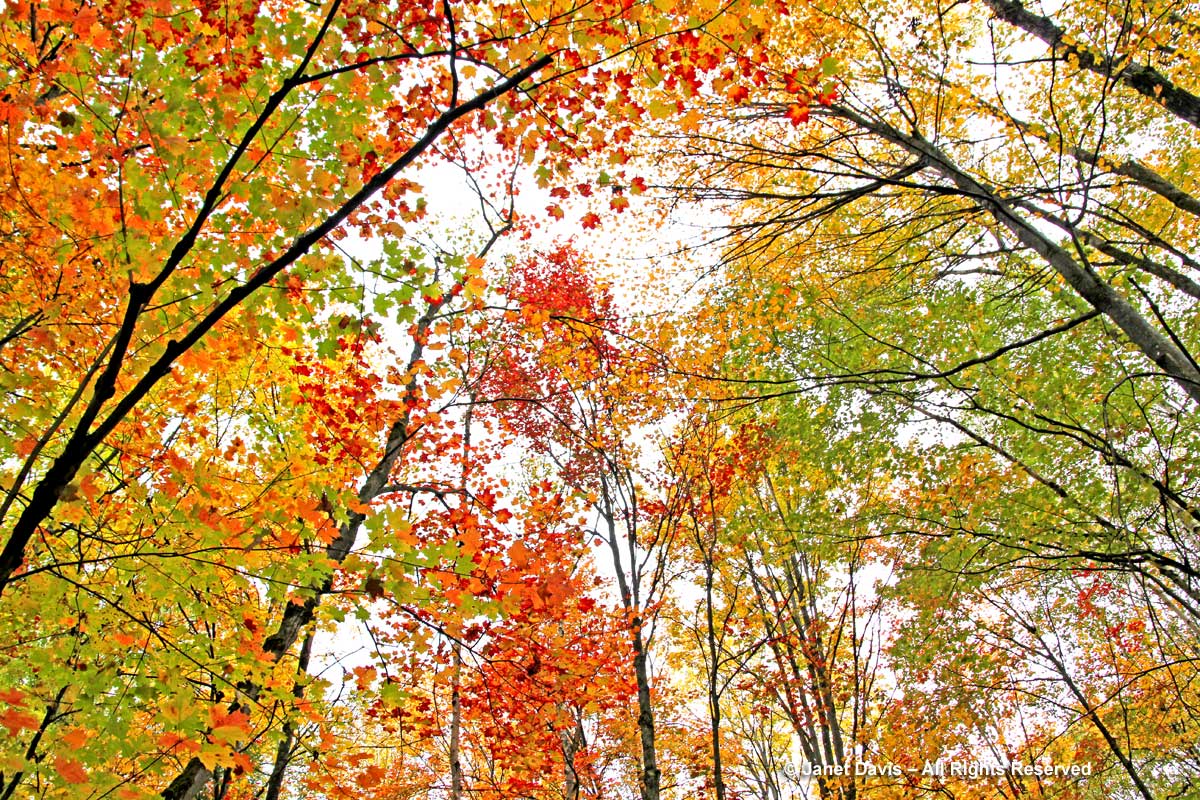
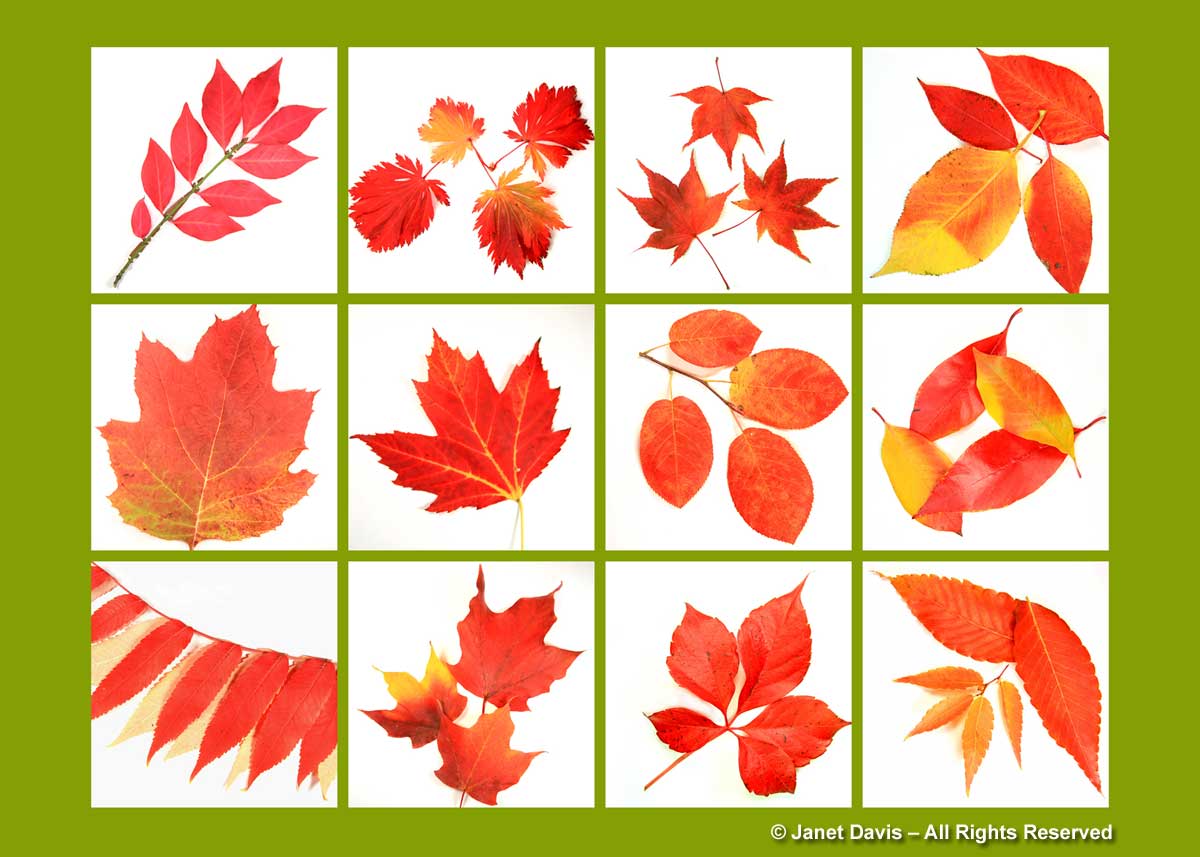
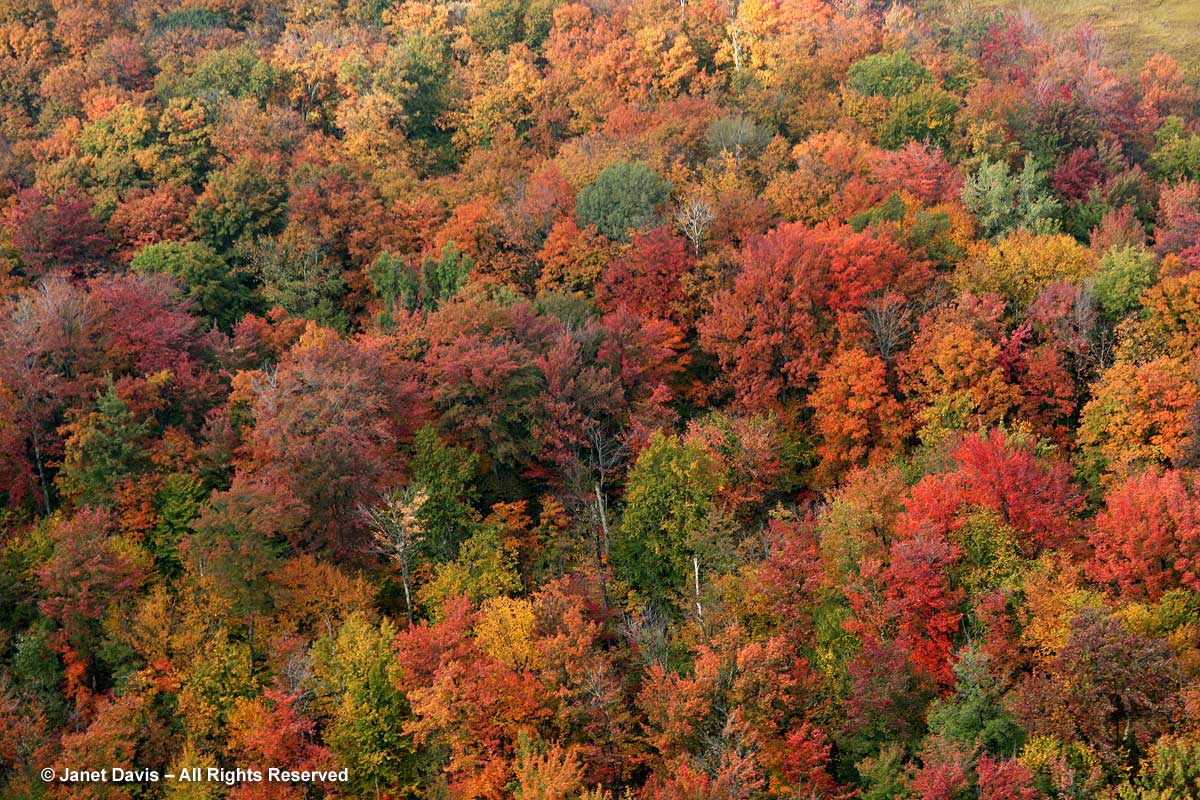
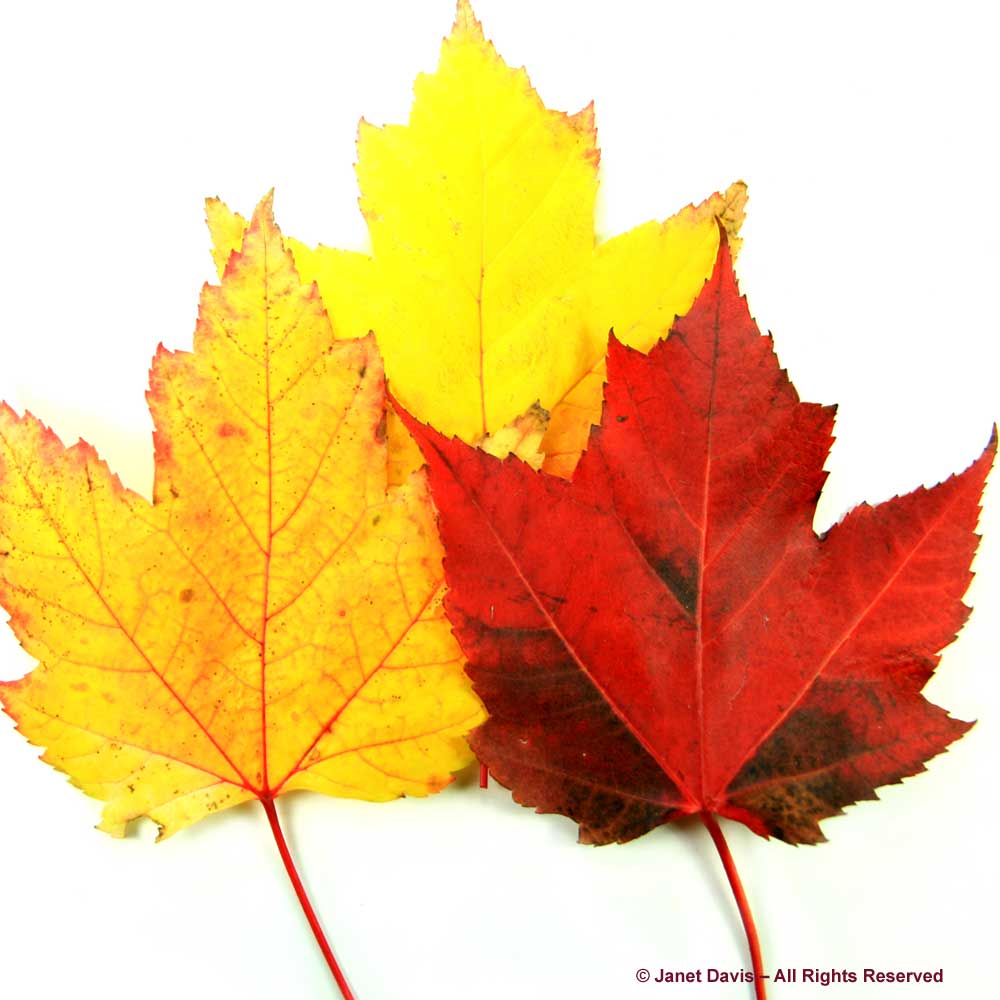
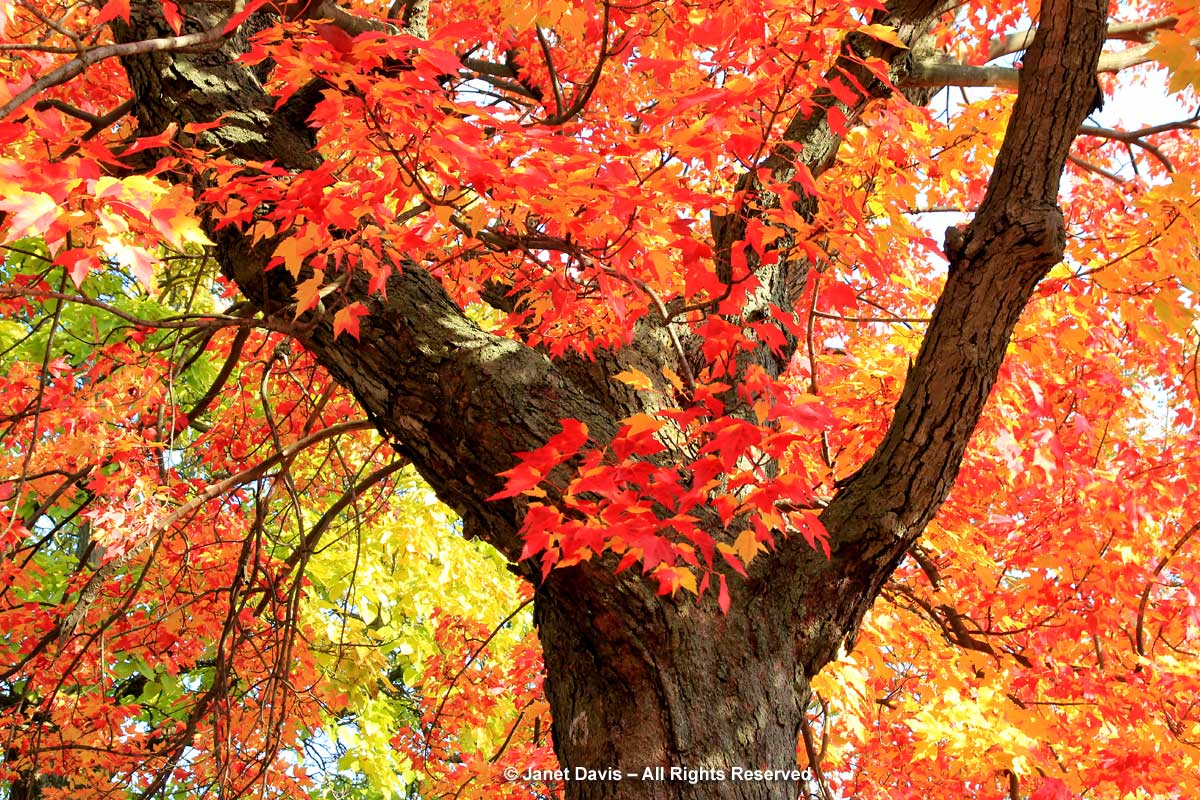
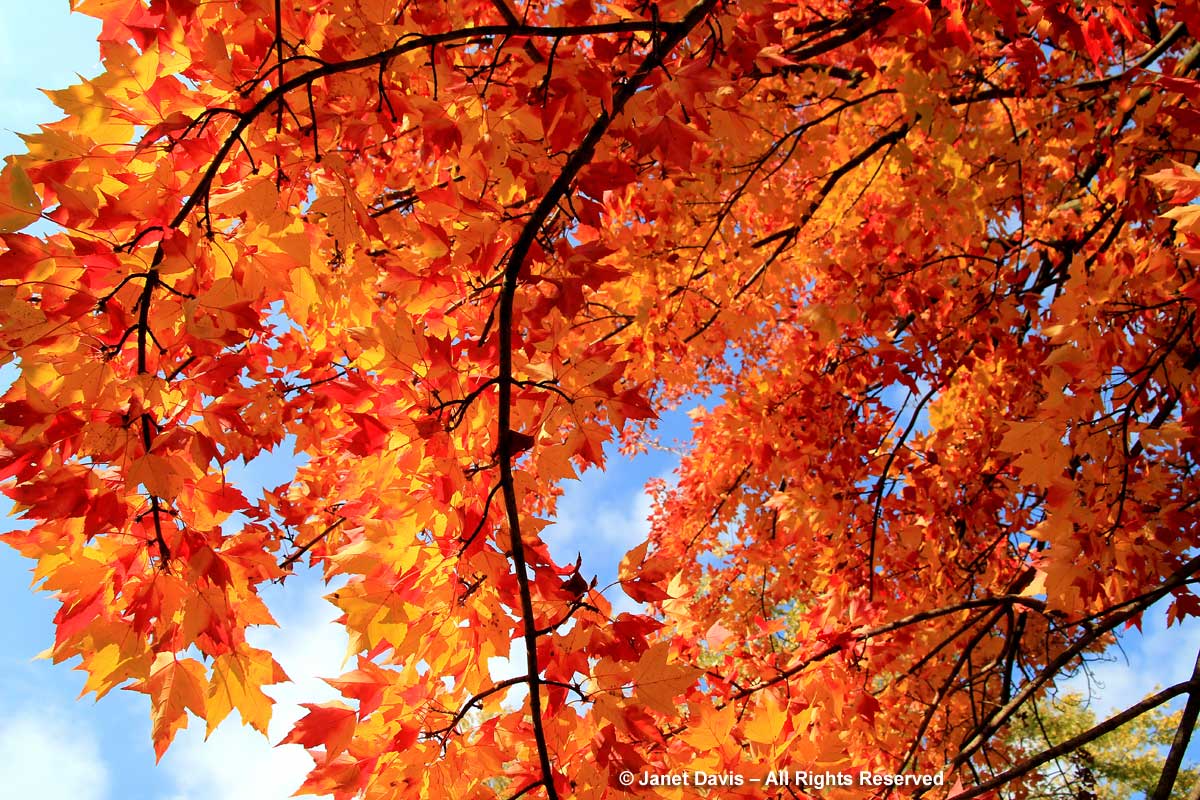
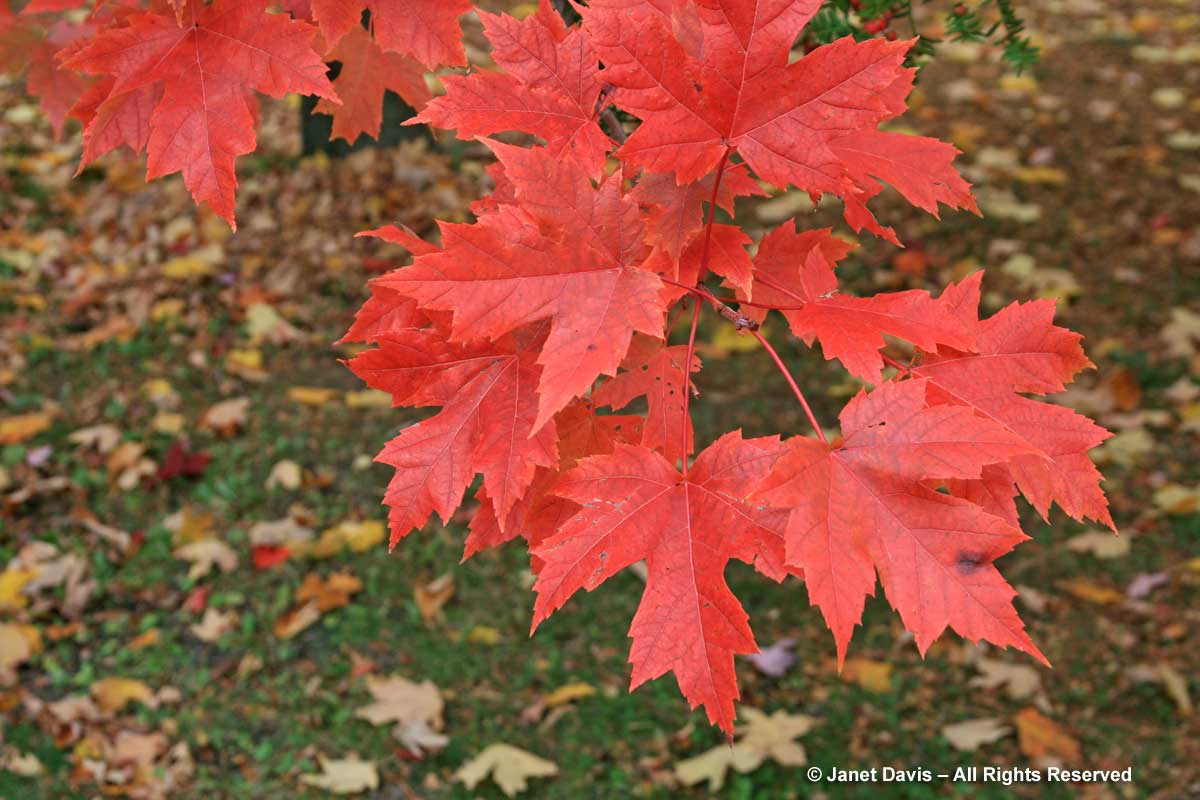
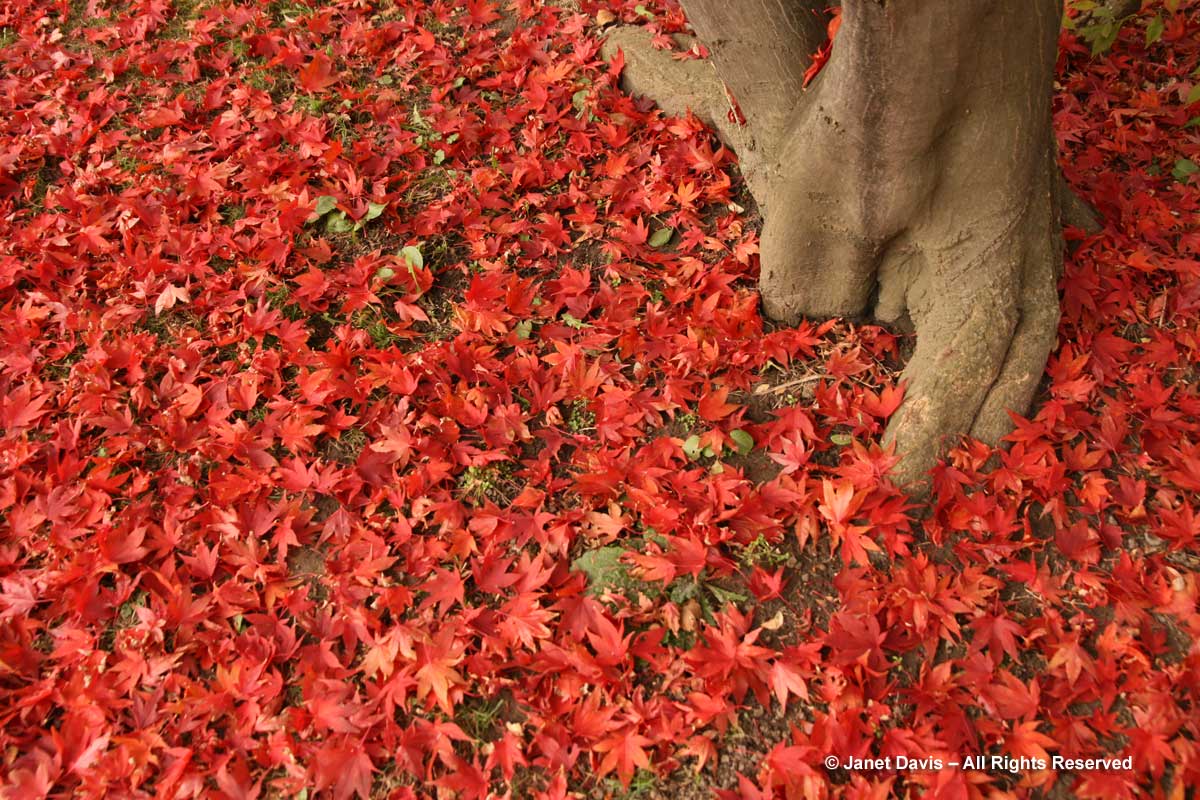
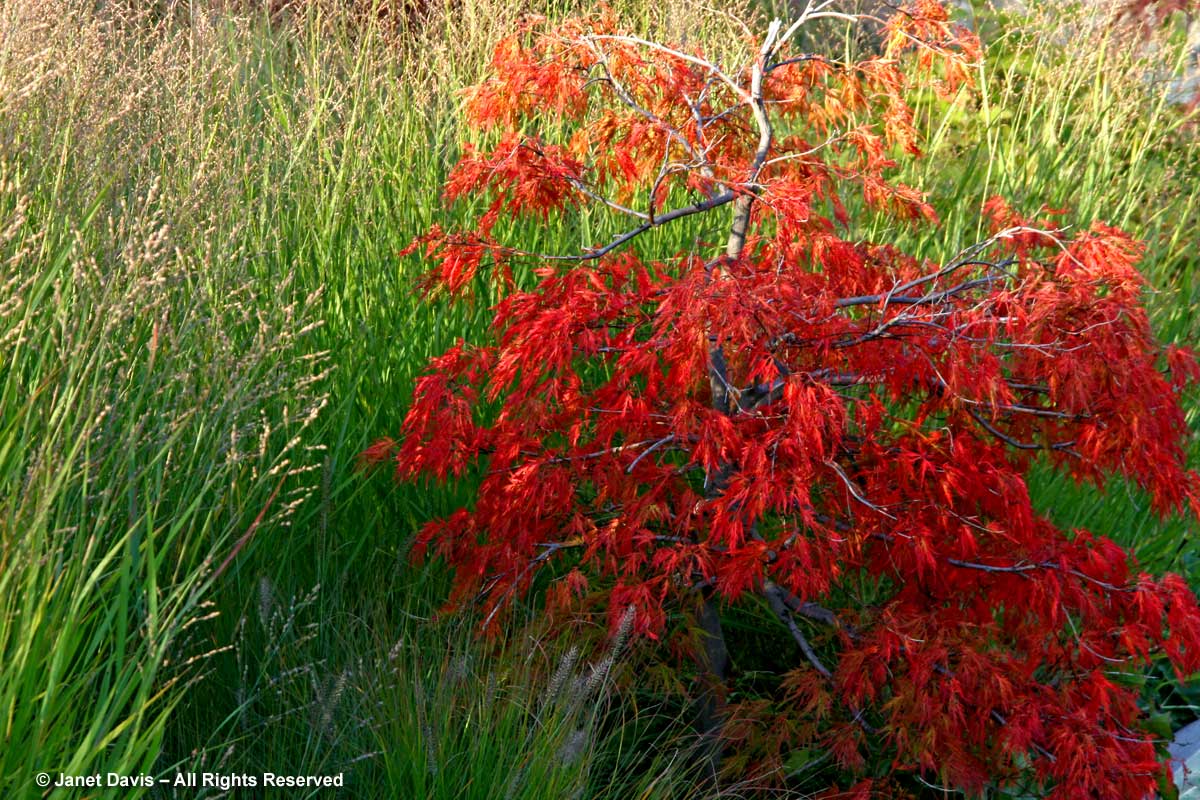
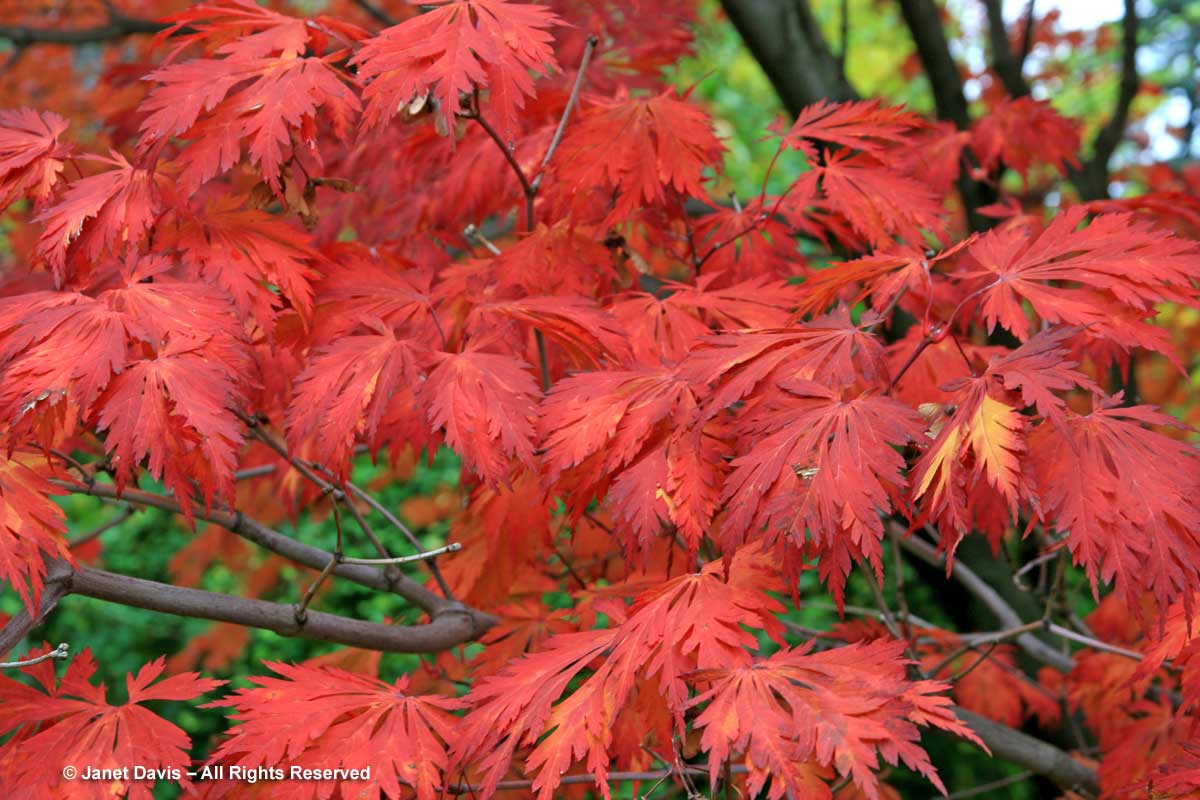
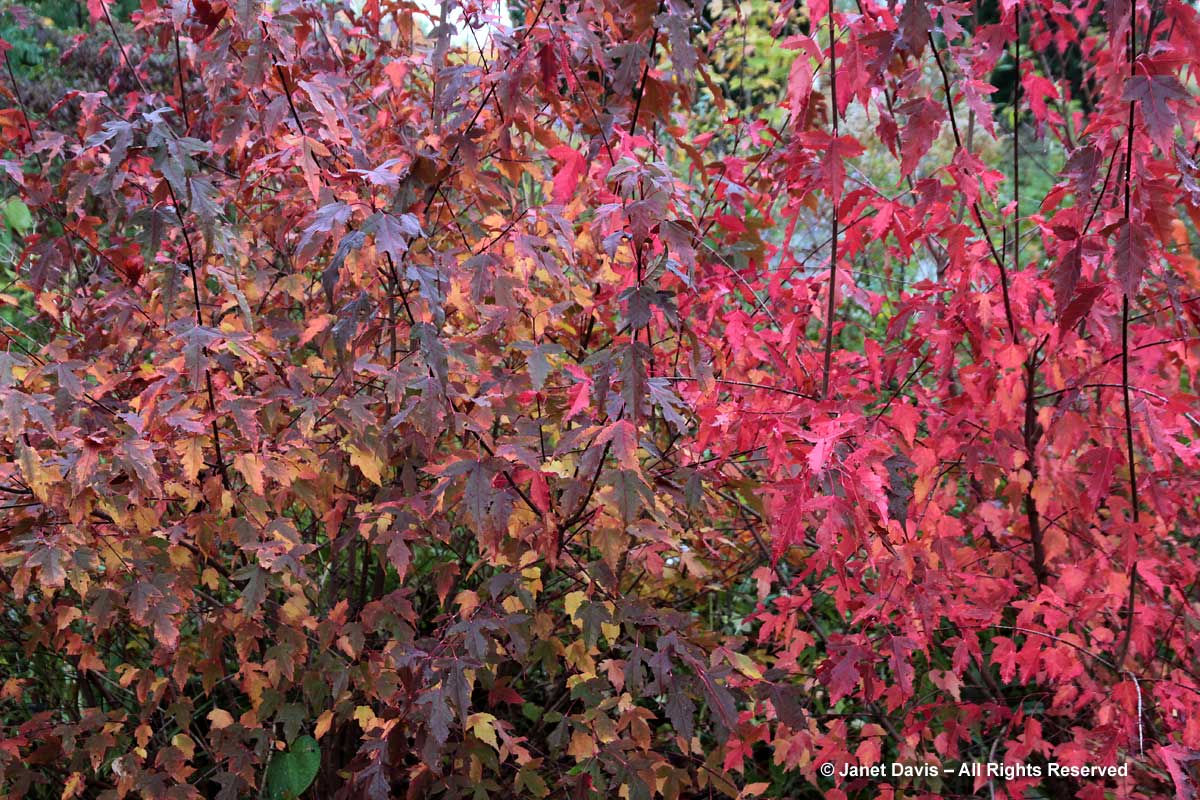
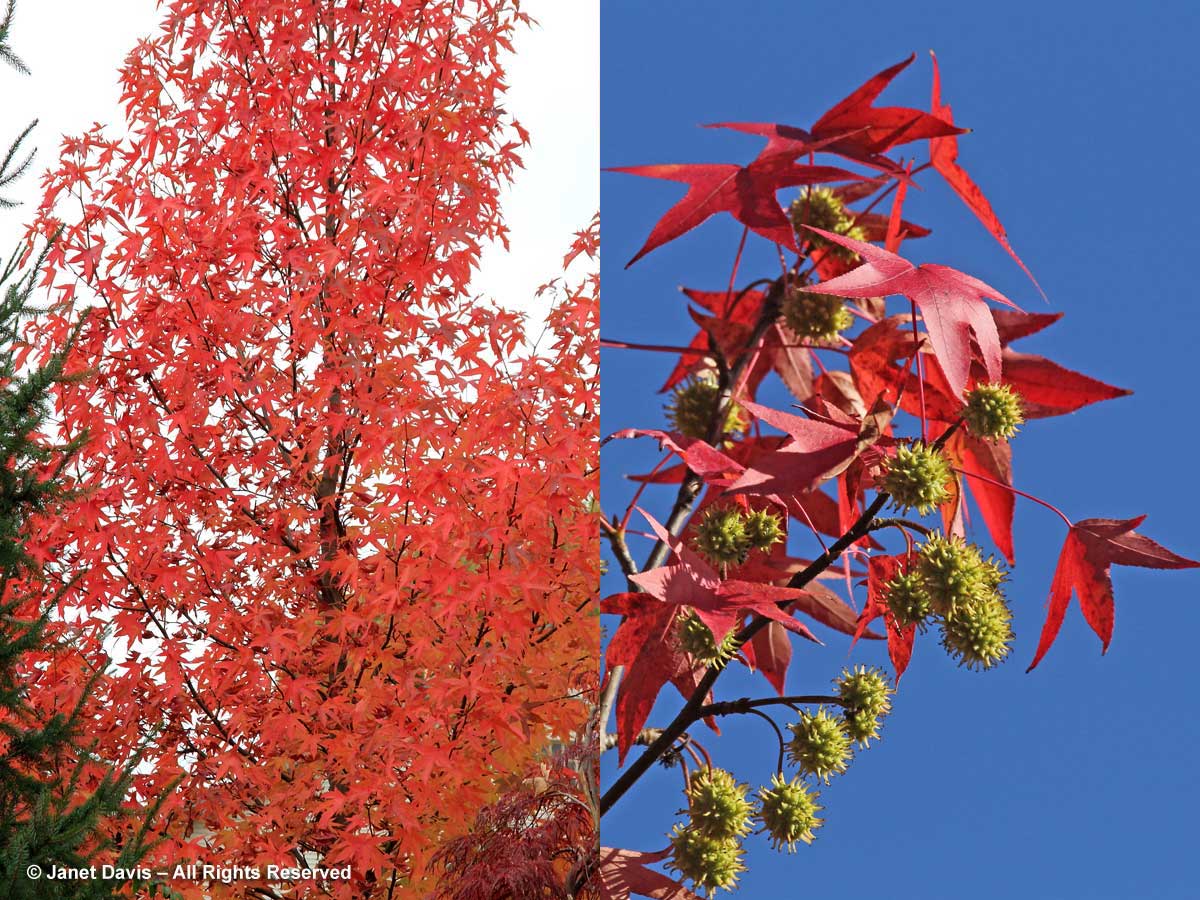
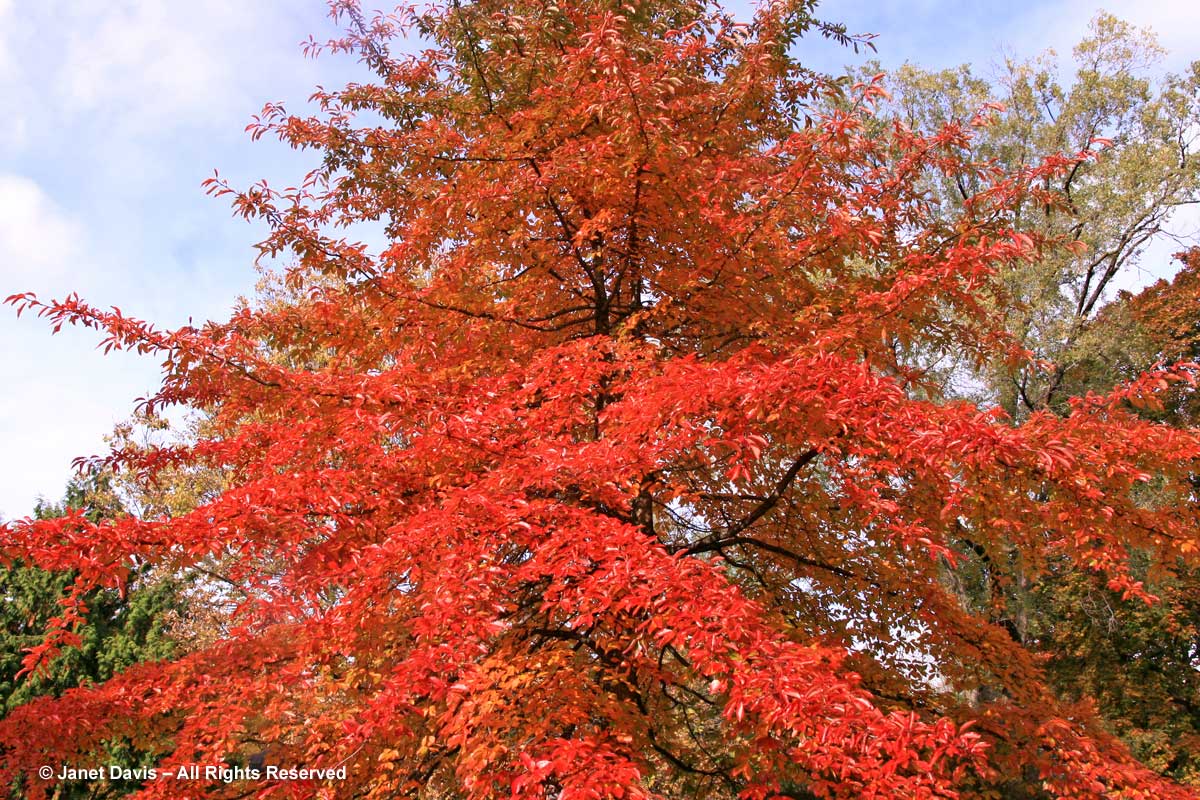
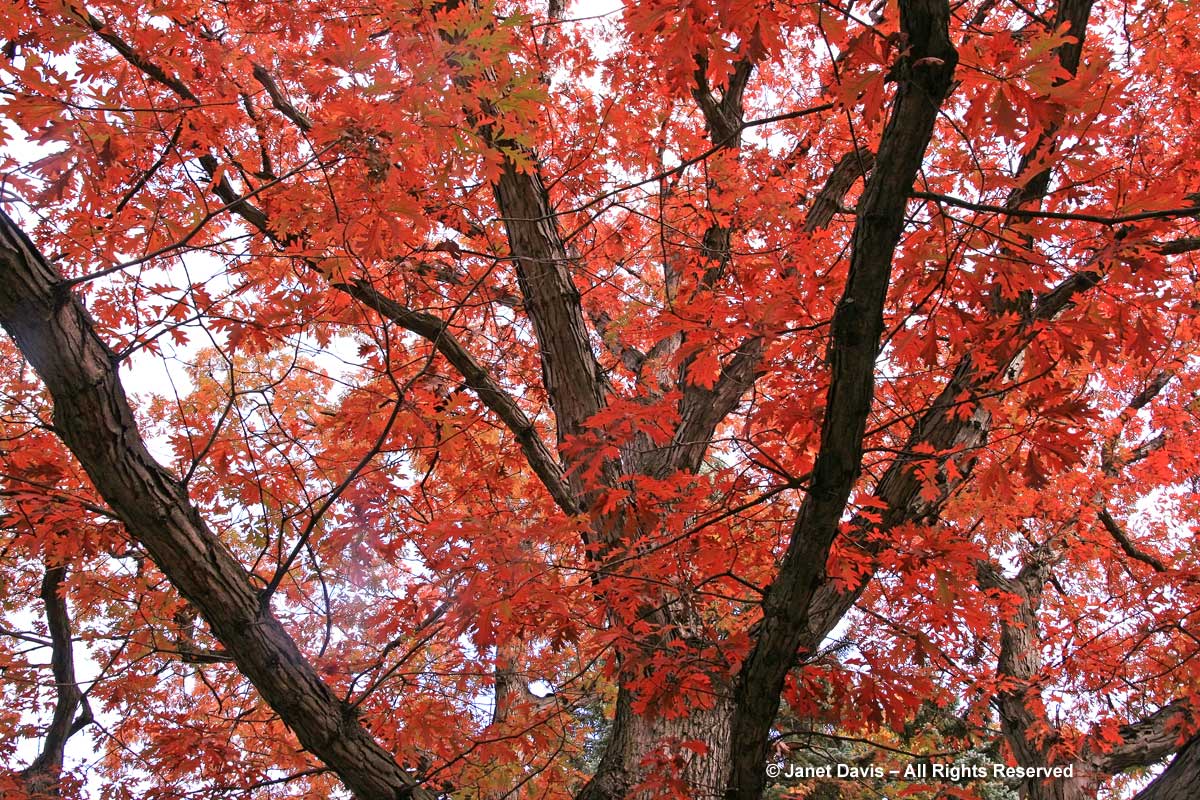
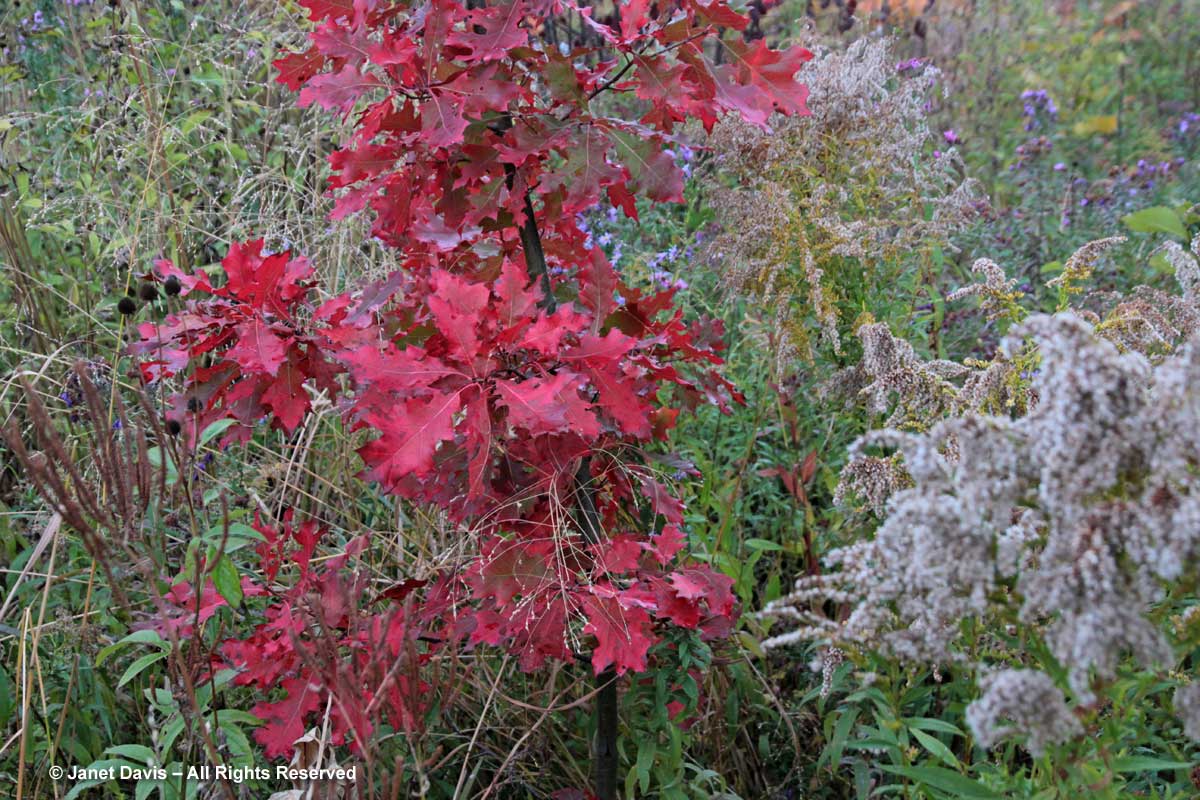
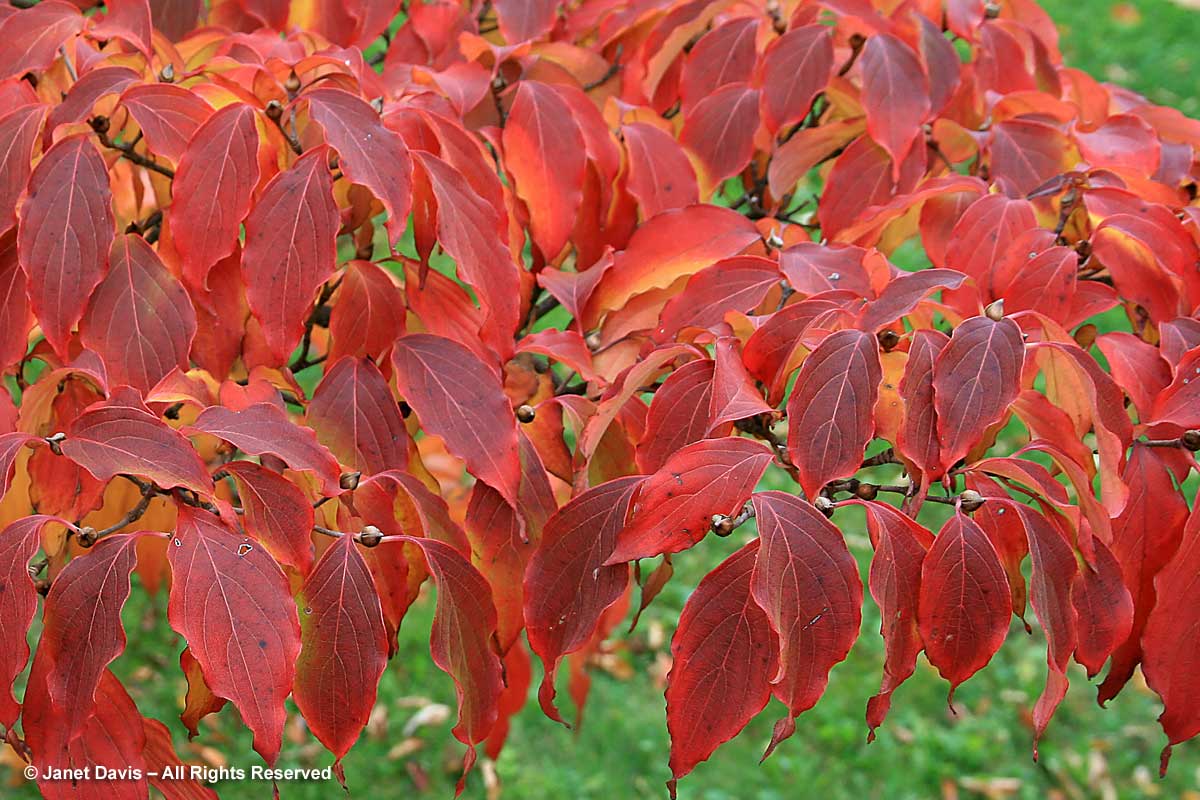
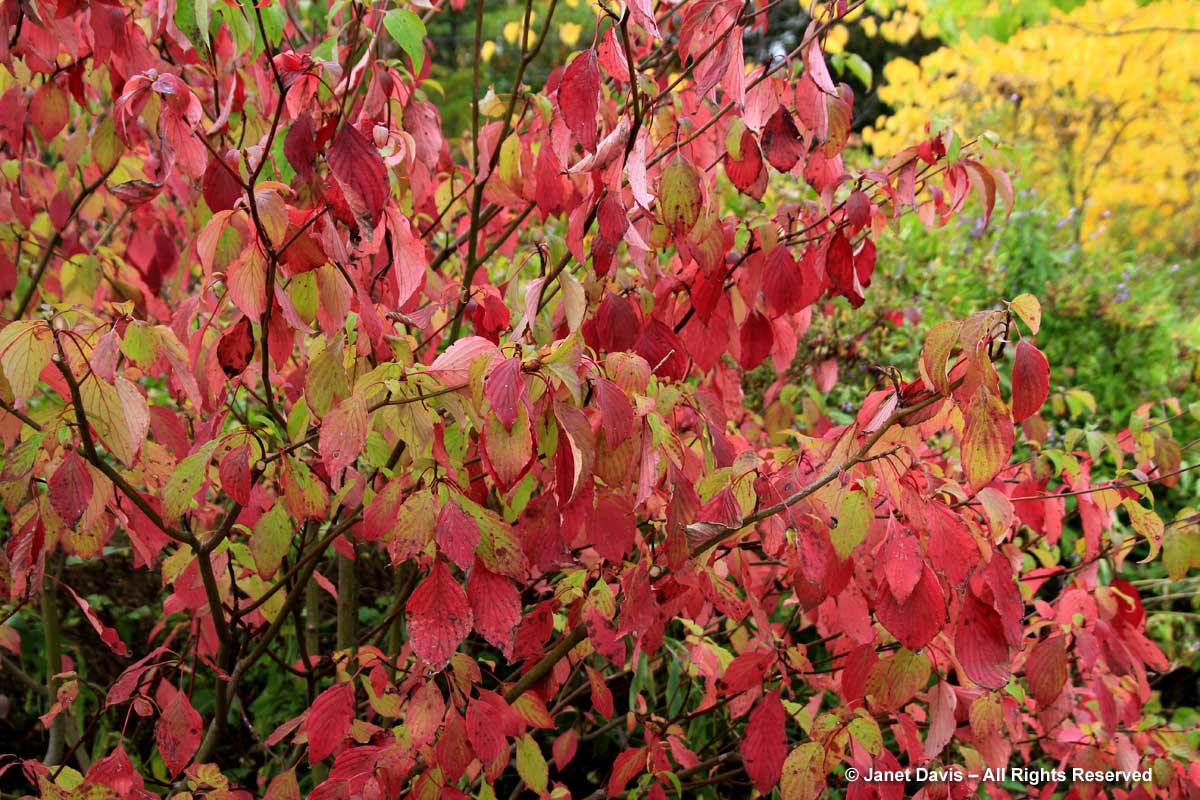
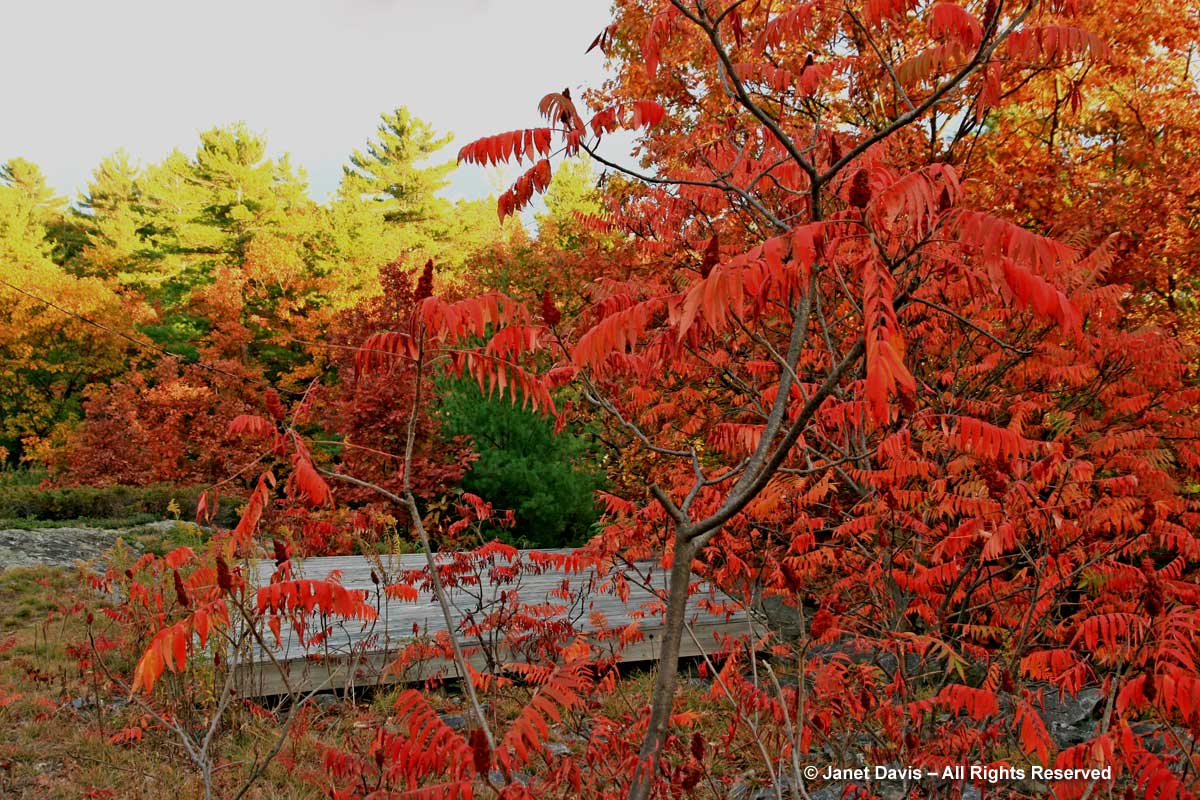
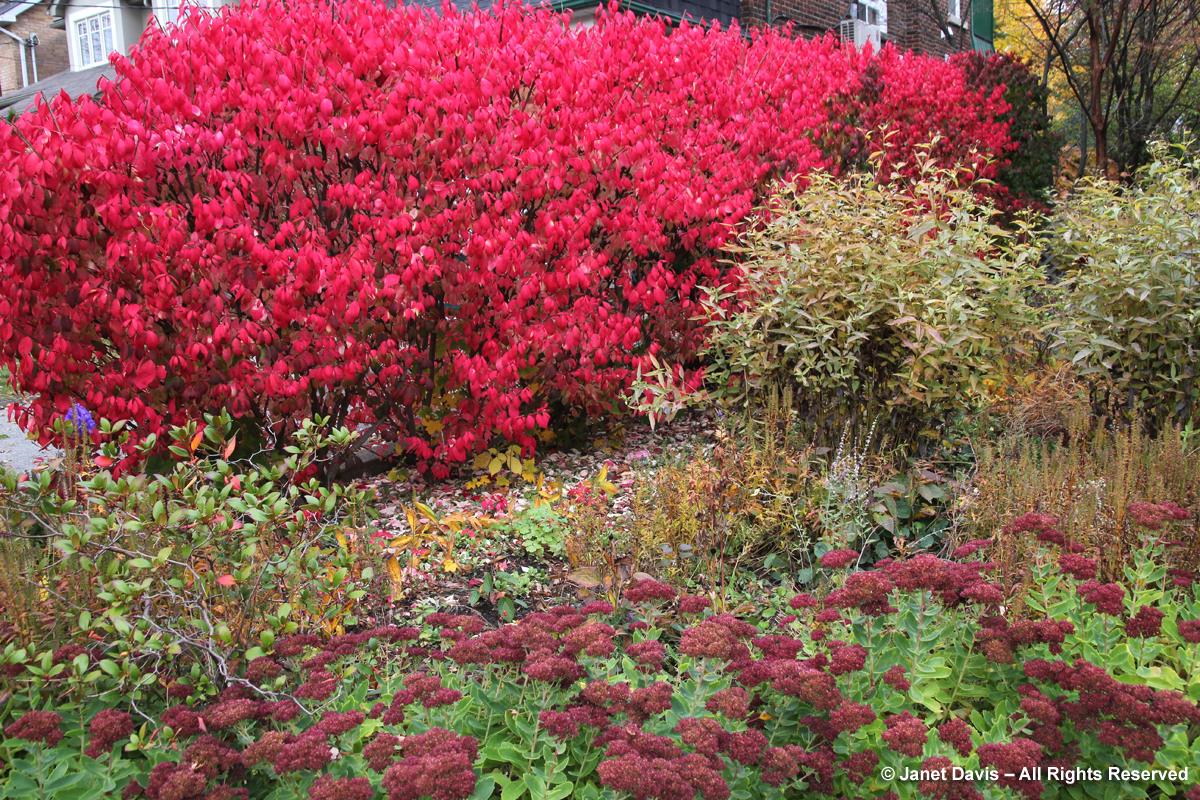
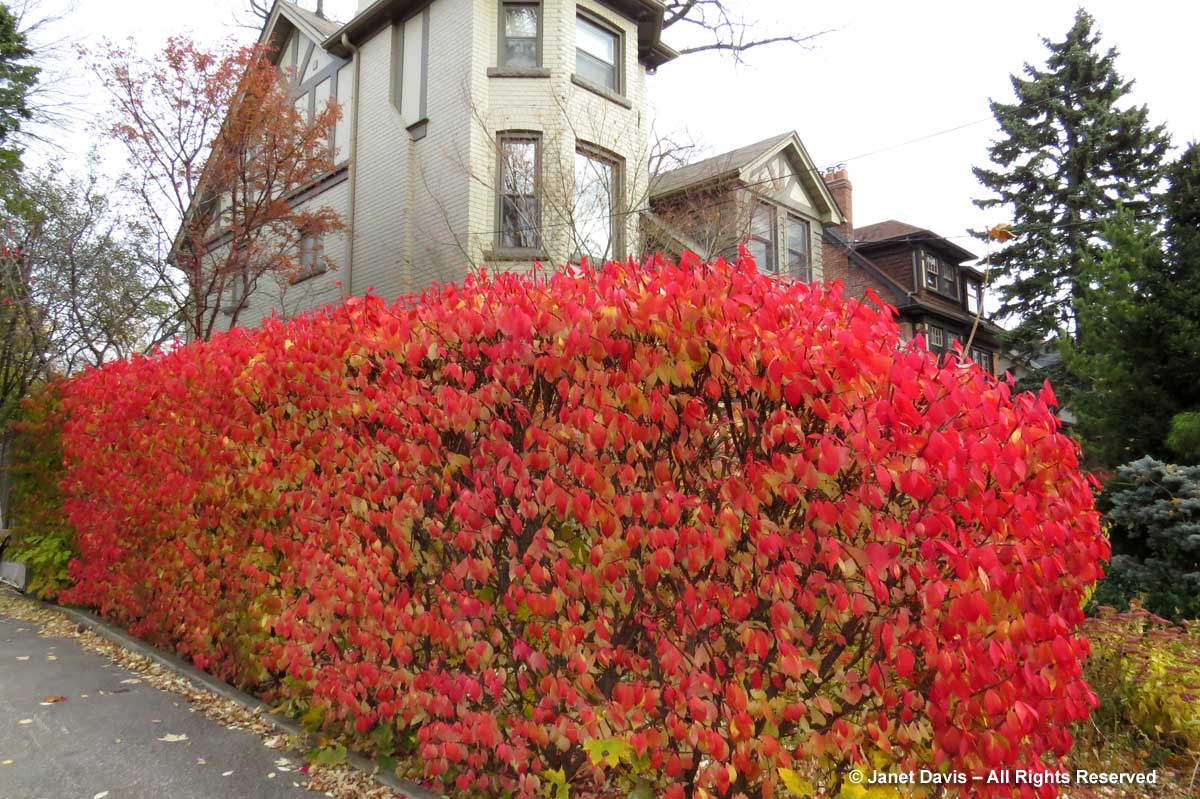
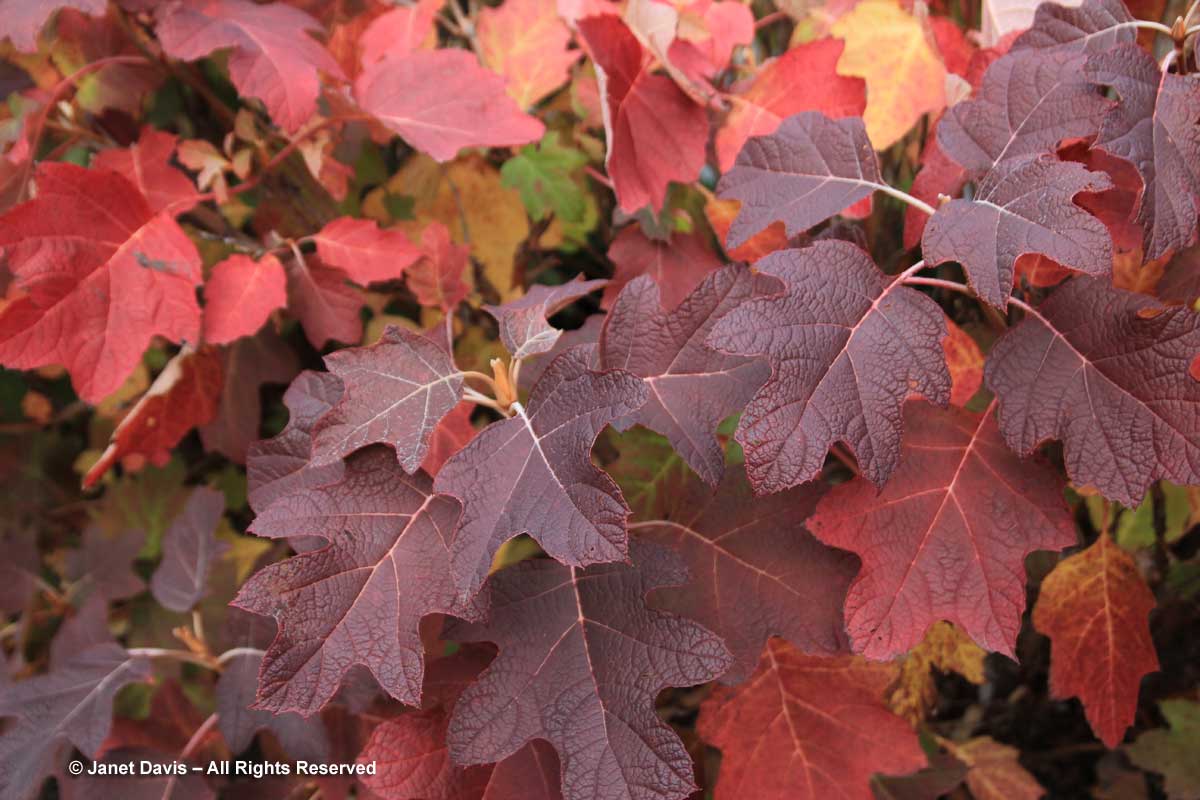
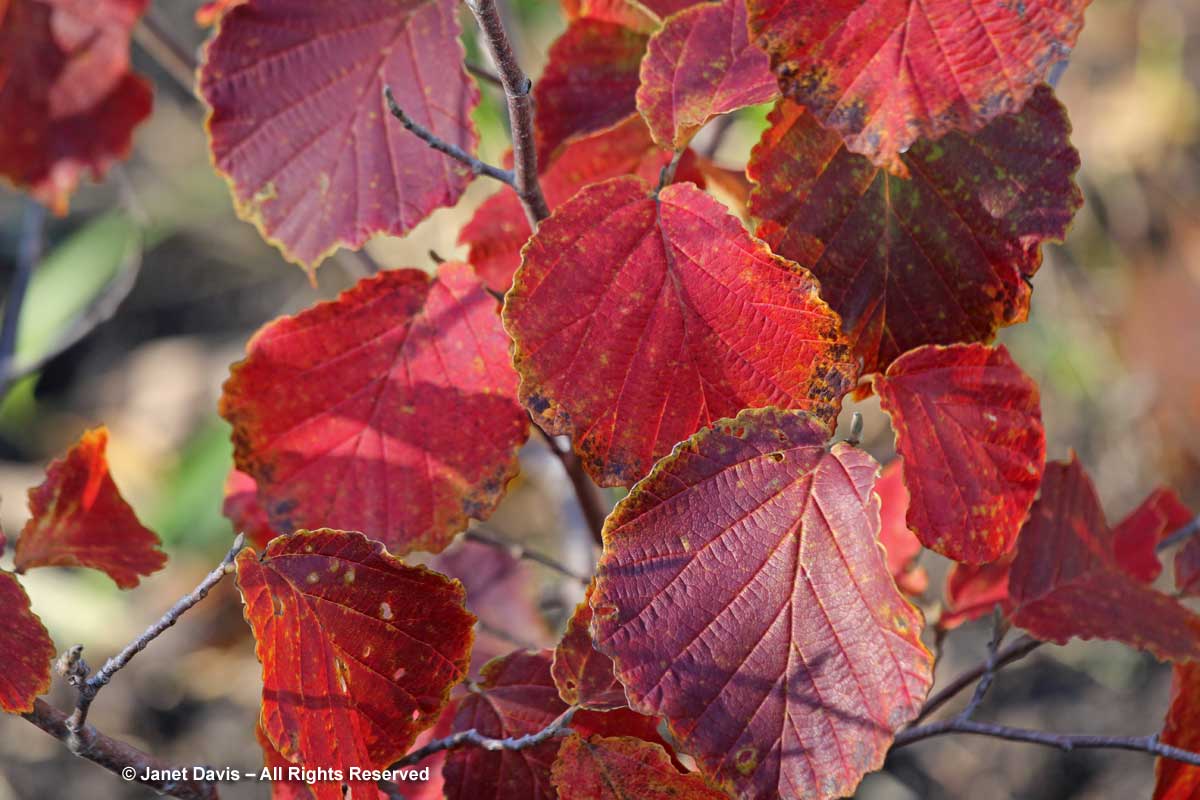
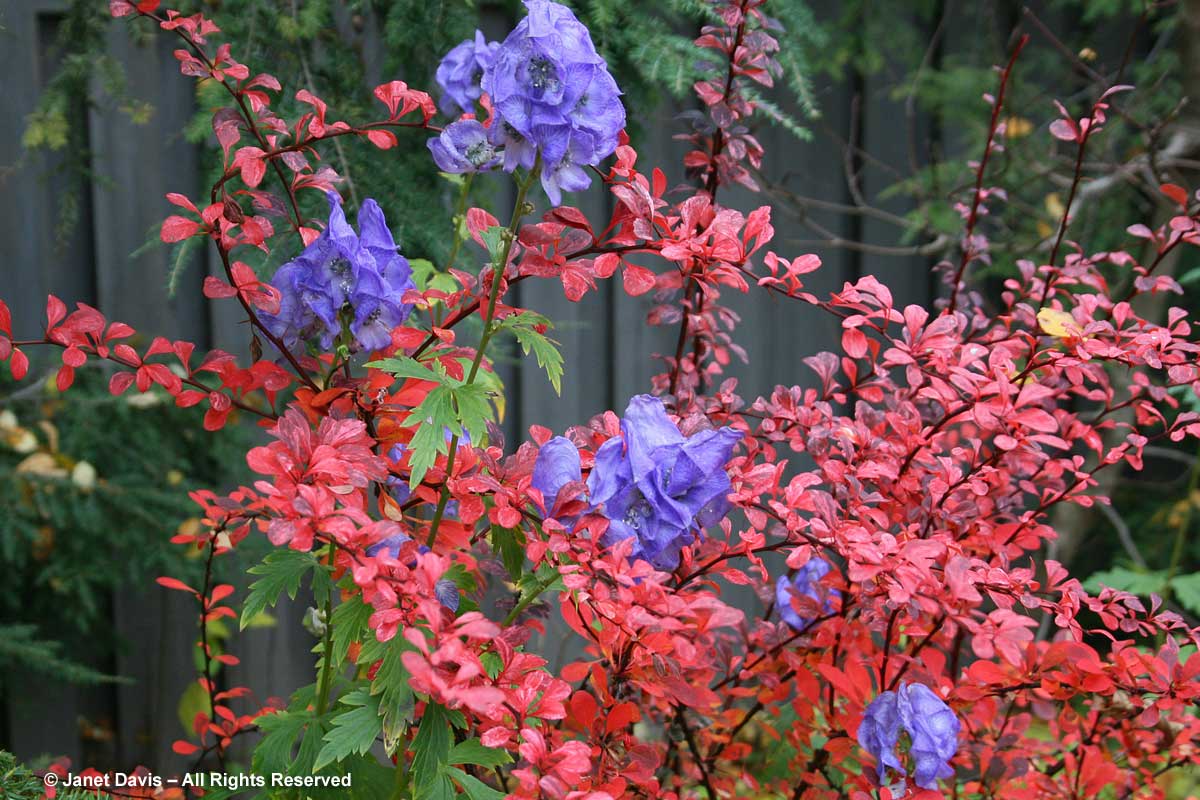
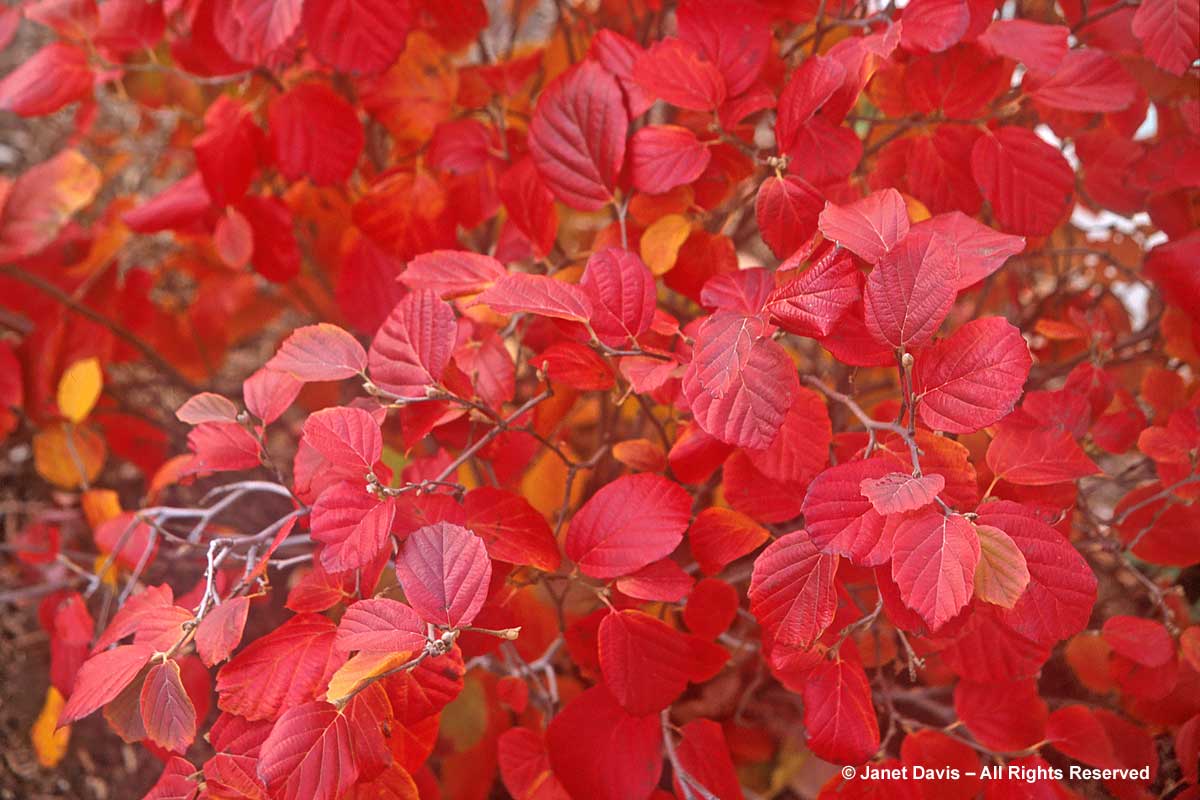
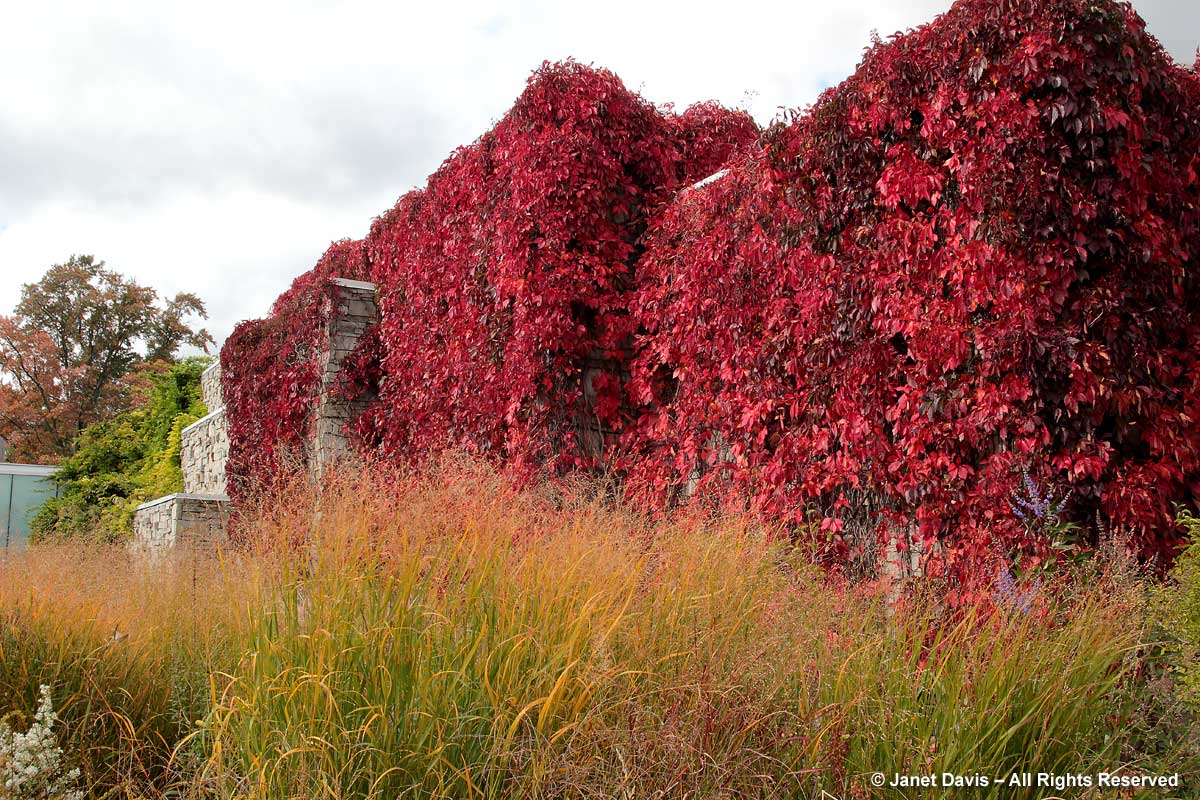
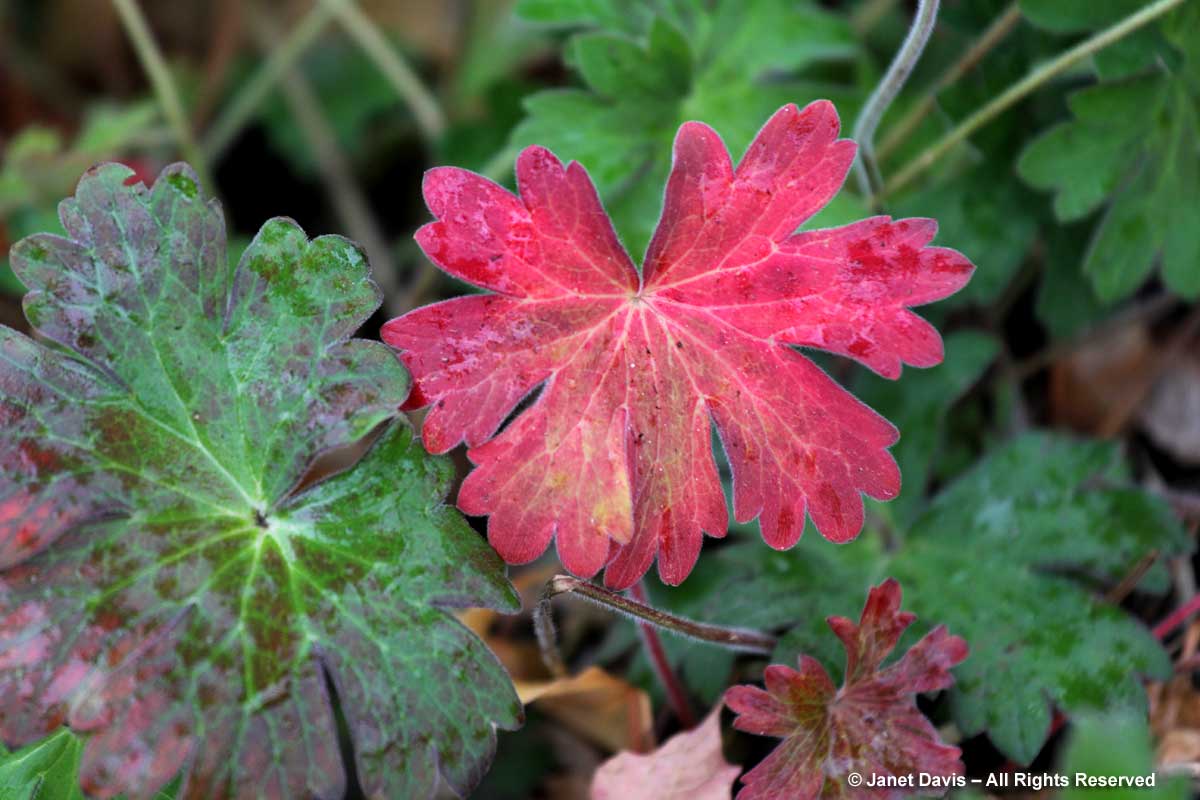
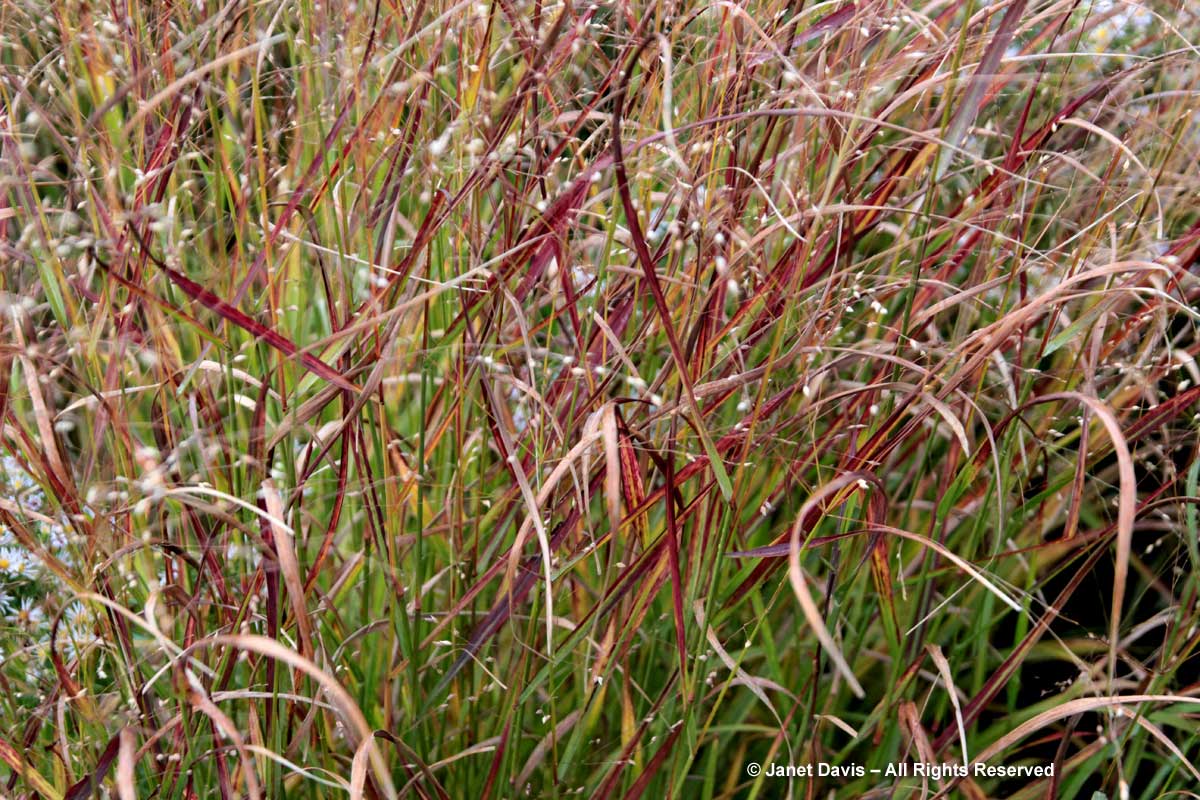
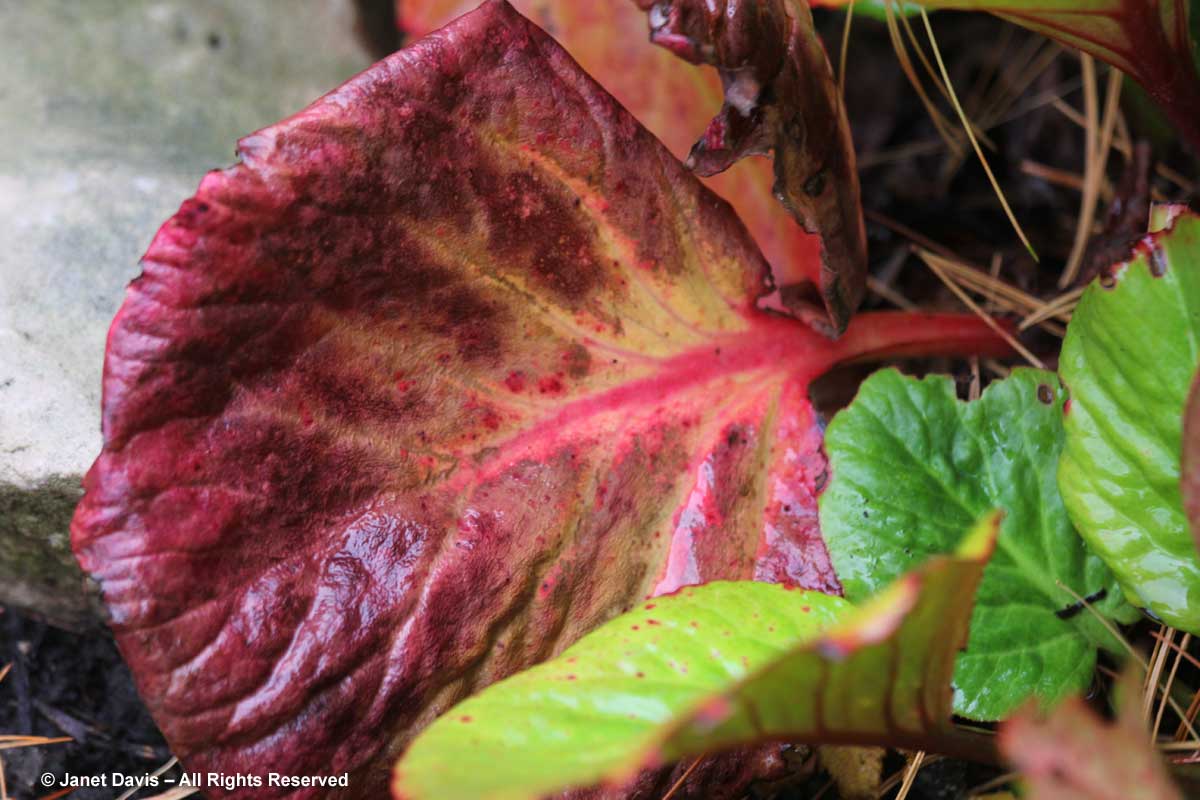
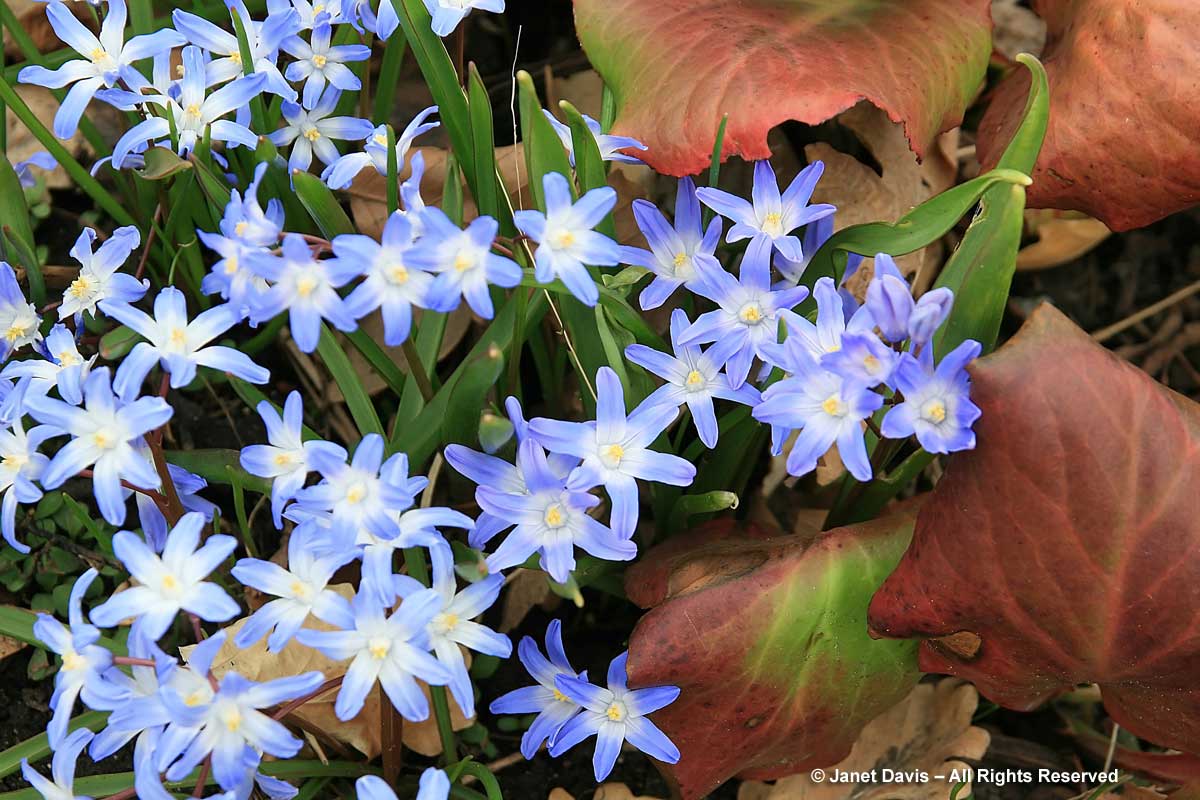
I adore autumn as well. The colour of the leaves, the mellow golden light, those blue sky days when nature seems to celebrate the end of another growing season and a job well done. Good post, Janet.
Thanks, Aldona. I have a hard time topping spring for optimism, but I love this time of year for reflection combined with gorgeous jewelbox colours.
Beautiful photos, as always.
Thank you, Rebecca!
Wonderfully done, Janet. And timely, as I am obsessing about new woody plantings particularly for autumn colour. Thank you. Now on to the oranges and yellows.
Oh, I envy you planting in your new place, Kristl. I hope my autumn colour pieces provide you with a little inspiration.
Luscious colours, and wonderful images. A nice reminder of where we were, not so long ago.
Thanks Helen! Such a beautiful season – not the “filled with hope and renewal” sentiment of spring, but the jewel tones that explode us into winter. I think capturing them with a camera is about trying to hold onto the magic of the green season.